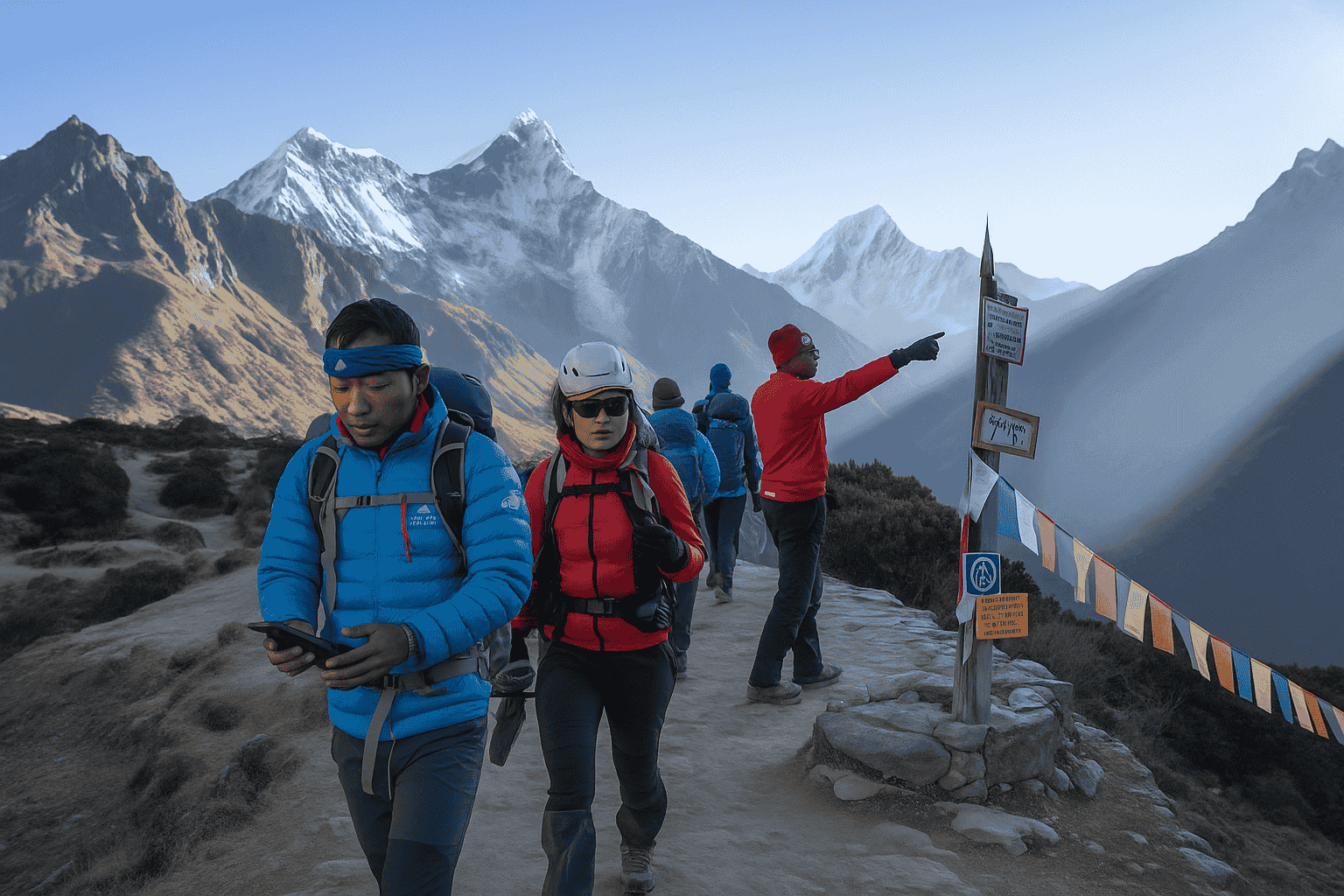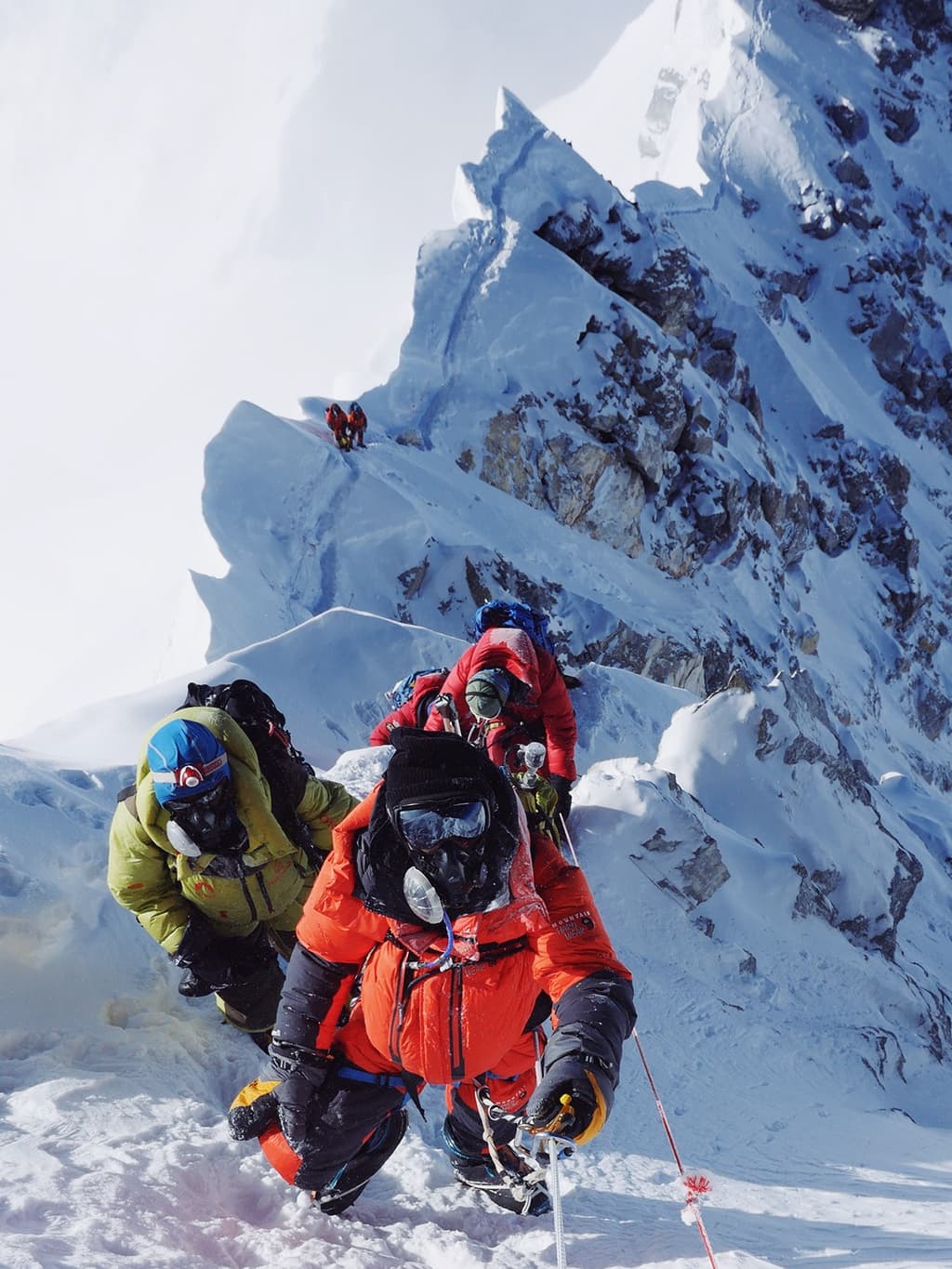Nepal's towering peaks and legendary trails continue to draw adventurers from around the world, but 2025 brings significant changes that every trekker needs to know about. This guide is designed for experienced hikers planning their return to the Himalayas and first-time trekkers dreaming of conquering Everest Base Camp or the Annapurna Circuit.
Recent infrastructure improvements have transformed many popular routes, while new permit requirements could catch unprepared trekkers off guard at the border. Technology advances now offer game-changing safety tools that weren't available just a few years ago, from satellite communication devices to real-time weather tracking apps.
We'll break down the latest trail conditions and what's actually changed on the ground, walk through the new permit process so you won't face delays, and explore how modern tech can keep you safer in remote mountain areas. Whether you're tackling your first 14-day trek or returning for your tenth Himalayan adventure, these updates will help you plan smarter and trek safer in current time.
Essential Safety Updates for Nepal Trekking
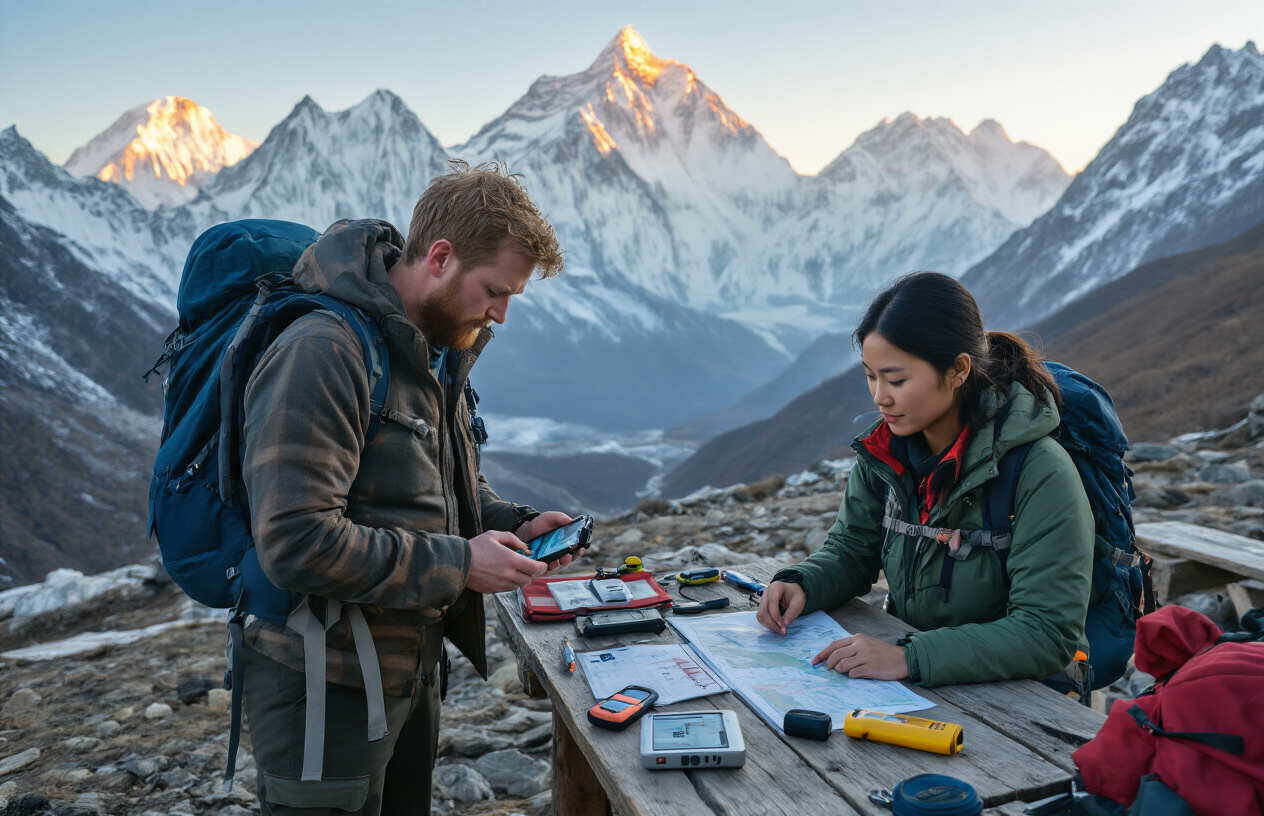
New Government Safety Regulations and Permits
The Nepal government rolled out comprehensive safety regulations starting January 2025, completely changing how trekkers approach popular routes. All solo trekkers must now hire a licensed guide for treks above 3,000 meters, ending the era of independent high-altitude adventures. This rule applies to major circuits including Everest Base Camp, Annapurna Circuit, and Langtang Valley.
The permit system got a major overhaul with digital tracking integration. Each trekking permit now includes a QR code that checkpoint officers scan to monitor your progress. Miss more than two consecutive checkpoints without a valid reason, and search teams automatically deploy. The new system costs an additional $25 per permit but provides real-time location data to emergency services.
Insurance requirements became stricter, too. Minimum coverage jumped to $50,000 for medical evacuation, up from the previous $10,000. Your insurance must specifically cover helicopter rescue above 5,000 meters, and standard travel insurance won't cut it anymore.
Enhanced Emergency Response Systems in Remote Areas
Satellite communication networks expanded dramatically across Nepal's trekking corridors. New emergency beacons are installed every 5-7 kilometers along major routes connecting directly to rescue coordination centers in Kathmandu and Pokhara. Press the red button, and trained responders receive your exact GPS coordinates within 60 seconds.
Helicopter landing pads multiplied throughout remote regions. The government built 47 new heliports in 2024, cutting average rescue response times from 6-8 hours to 2-4 hours in most areas. Popular destinations like Gokyo Lakes, Thorong La Pass, and Upper Mustang now have dedicated rescue infrastructure.
Medical posts received significant upgrades with telemedicine capabilities. Remote health stations can now video-conference with doctors in Kathmandu, providing expert consultation for altitude sickness, injuries, and other medical emergencies. Each post stocks oxygen concentrators, advanced first aid supplies, and satellite phones.
Updated Weather Monitoring and Early Warning Systems
Nepal's Department of Hydrology and Meteorology launched an advanced warning network specifically for trekkers. Mountain weather stations doubled from 23 to 46 locations, providing hyperlocal forecasts for elevation bands every 500 meters. Real-time data streams to a mobile app that sends push notifications about incoming storms, temperature drops, and avalanche risks.
The early warning system connects to lodge networks through digital displays showing current conditions, 72-hour forecasts, and risk assessments color-coded from green to red. Lodge owners receive training to interpret warnings and guide trekkers appropriately.
Avalanche monitoring improved with new snow stability sensors on high-risk passes. Automated systems measure snowpack layers, temperature gradients, and wind loading to predict avalanche probability. Critical passes like Thorong La and Cho La get daily stability reports posted at approach points.
Mandatory Safety Equipment Requirements
Equipment requirements vary by elevation and season, but certain items have become non-negotiable. All trekkers must carry personal locator beacons (PLBs) above 4,000 meters. These devices cost around $200-300 but integrate with Nepal's rescue network for instant emergency alerts.
Communication gear expanded beyond basic phones. Satellite messengers like Garmin inReach or SPOT devices are mandatory for groups venturing beyond established tea house routes. These devices work when cell towers fail and provide two-way messaging with rescue services.
Medical kits have specific requirements, too. Every group needs prescription altitude sickness medication (Diamox and Dexamethasone), pulse oximeters for monitoring oxygen saturation, and emergency oxygen supplies for treks above 4,500 meters. Guides must complete wilderness first aid certification every two years.
Weather protection standards increased with mandatory four-season sleeping bags rated to -15°C for high-altitude treks, waterproof-breathable outer shells meeting specific performance criteria, and insulation layers appropriate for elevation zones. Rental gear must meet these standards and undergo regular safety inspections.
Trail Conditions and Infrastructure Improvements
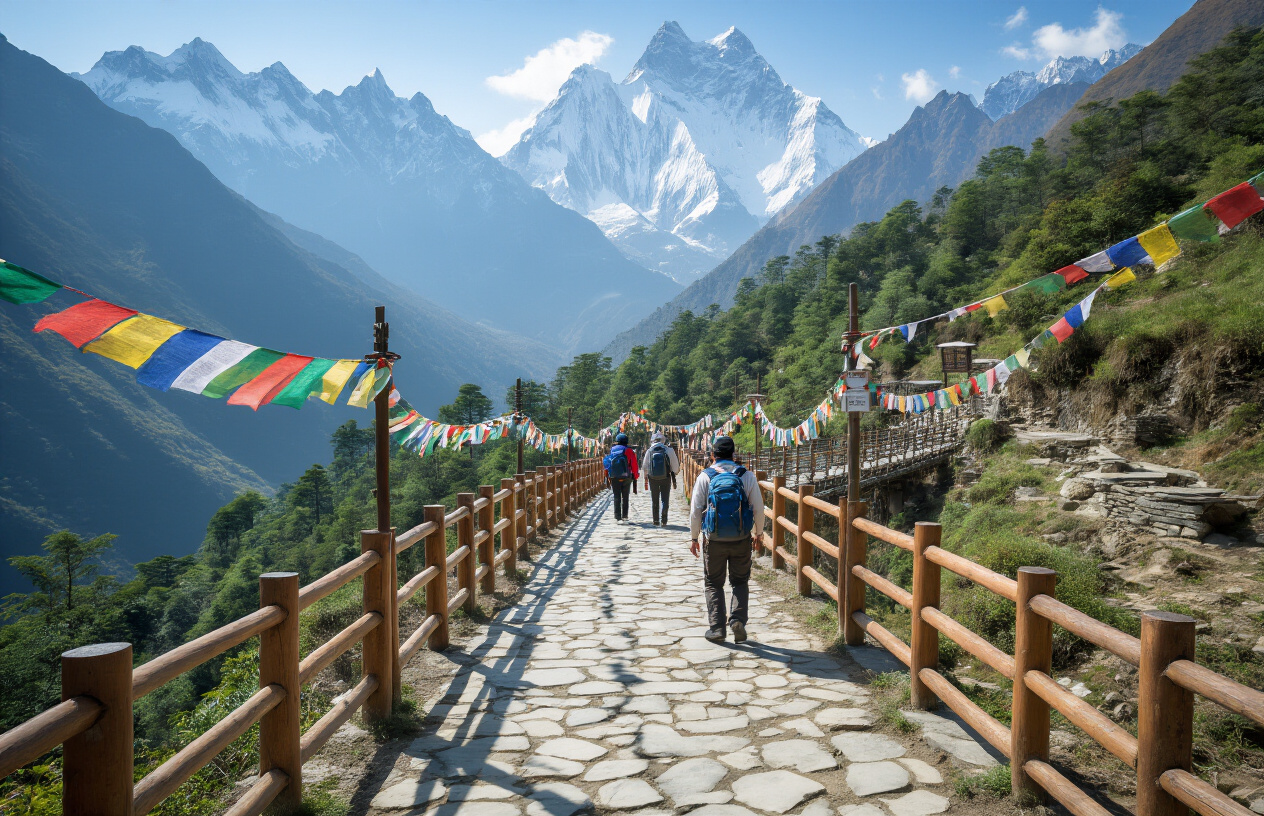
Post-Earthquake Reconstruction Progress on Popular Routes
Major trekking routes across Nepal have undergone significant reconstruction since the 2015 earthquakes, with remarkable progress visible throughout 2024 and early 2025. The Everest Base Camp trail now features completely rebuilt sections between Namche Bazaar and Tengboche, where unstable terrain previously caused concern for trekkers. New retaining walls and reinforced pathways have made these segments safer and more accessible.
The Annapurna Circuit has seen extensive work on the Thorong La approach, with engineers installing new drainage systems to prevent monsoon damage and landslides. Previously treacherous sections near Manang now have solid stone pathways replacing the old, crumbling trails. Reconstruction teams have also addressed the notorious rockfall zones by building protective barriers and rerouting paths where necessary.
Langtang Valley, which suffered devastating damage during the earthquake, has been almost entirely rebuilt. The trail from Syabrubesi to Langtang village now follows a safer route with improved gradient management. Local communities worked alongside international aid organizations to create more resilient infrastructure that can withstand future seismic activity.
Recovery efforts have included upgrading emergency evacuation routes and establishing multiple helicopter landing zones at strategic intervals. These improvements mean rescue operations can reach trekkers more efficiently, reducing response times from hours to minutes in many locations.
New Bridge Installations and Path Upgrades
Nepal's Department of Tourism has invested heavily in bridge infrastructure, replacing dozens of aging suspension bridges with modern steel structures. The new bridges feature wider walkways, better railings, and weather-resistant materials designed to last decades rather than requiring annual repairs.
On the Everest trail, three major bridges have been installed or upgraded since 2023. The famous Hillary Bridge near Namche Bazaar received structural reinforcements and a complete deck replacement. Two entirely new bridges now span previously difficult river crossings between Lukla and Phakding, eliminating dangerous ford crossings during high water periods.
The Annapurna region benefited from eight new bridge installations, particularly along the Marsyangdi River valley. These bridges connect previously isolated villages and provide alternative routes when main paths become impassable. Engineers designed them with higher clearances to accommodate increased river flows caused by glacial melt.
Path upgrades extend beyond bridges to include stone paving projects on heavily trafficked sections. Teams have laid over 50 kilometers of stone pathways with proper drainage channels. These improvements reduce erosion during monsoon seasons and provide a stable footing year-round. Solar-powered lighting systems now illuminate several dangerous night-walking sections, particularly around major villages where trekkers might arrive after dark.
Improved Teahouse Standards and Facilities
Teahouse accommodations have transformed dramatically, with new standards implemented across major trekking circuits. The Nepal Tourism Board introduced certification programs requiring teahouses to meet specific criteria for cleanliness, safety, and environmental responsibility. Over 200 teahouses received upgrades in 2024 alone.
Modern teahouses now feature improved insulation, reducing the need for constant heating and making rooms more comfortable during cold mountain nights. Many have installed solar water heating systems, providing hot showers even at high altitudes where fuel costs previously made this luxury prohibitive. Beds now come with proper mattresses instead of thin foam pads, and clean bedding is standard rather than optional.
Bathroom facilities have seen the most dramatic improvements. Flush toilets are becoming common even at moderate altitudes, replacing basic pit latrines. Teahouses above 4,000 meters have invested in composting toilet systems that handle waste more effectively in cold climates. Hand-washing stations with soap are now mandatory at all certified establishments.
Kitchen upgrades include better ventilation systems to reduce indoor air pollution, stainless steel food preparation surfaces, and improved food storage facilities. Many teahouses have added water purification systems, providing safe drinking water without requiring trekkers to rely solely on bottled water or purification tablets.
WiFi connectivity has expanded to most teahouses along main routes, though connection quality varies with altitude and weather conditions. Solar charging stations are now standard amenities, allowing trekkers to keep devices powered without carrying multiple battery packs.
Permit Changes and Bureaucratic Updates
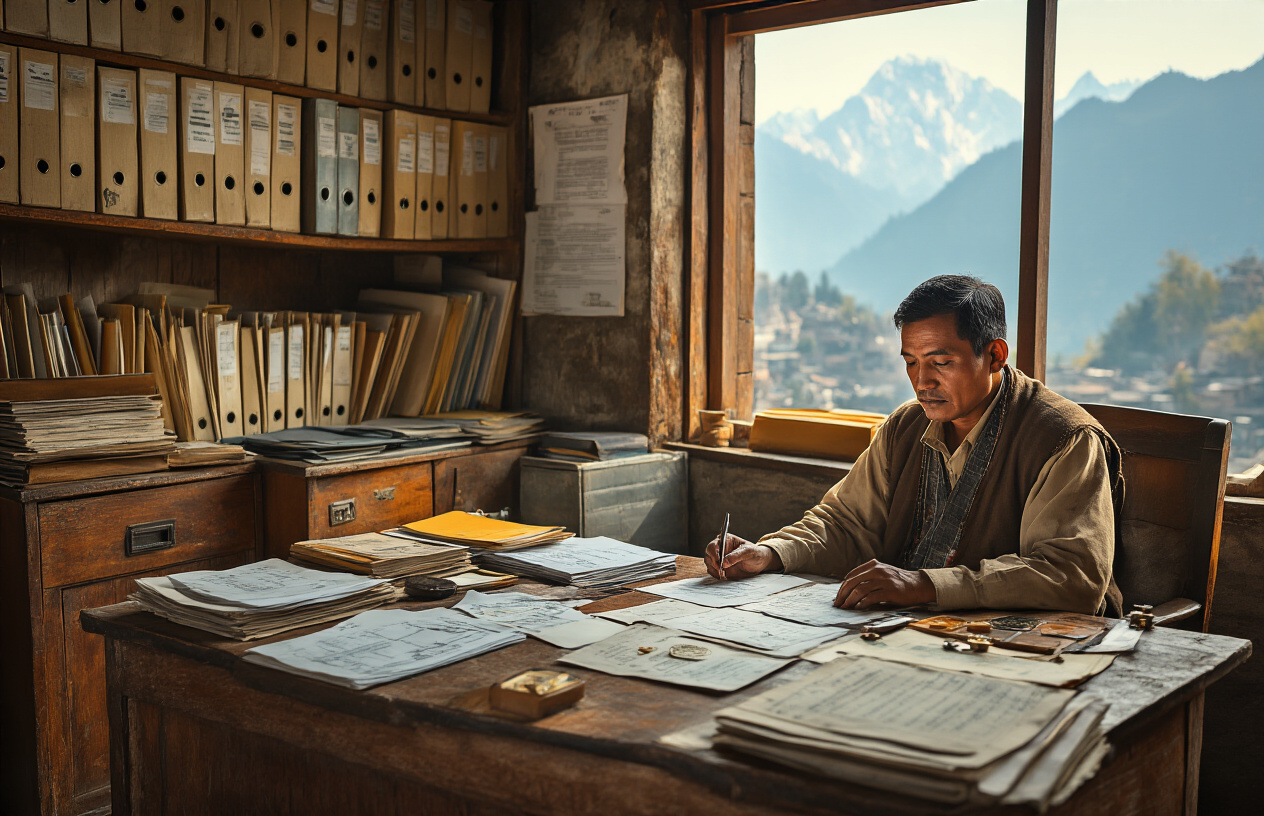
Streamlined Online Permit Application Process
Nepal's permit system has undergone a digital transformation that makes getting trekking permits much easier than before. The Department of Tourism launched a comprehensive online platform where you can apply for most permits from anywhere in the world. This system connects directly with immigration databases, reducing processing times from several days to just 24-48 hours for most applications.
The new digital portal accepts international payment methods, including major credit cards and PayPal, eliminating the need to carry exact cash amounts or visit banks for money exchanges. You'll receive QR-coded permits that can be scanned at checkpoints, making the verification process lightning-fast for both trekkers and checkpoint officers.
Mobile app integration allows you to store all permits digitally on your smartphone, with offline access capabilities for areas with limited connectivity. The system also sends automatic reminders about permit expiration dates and renewal requirements for longer treks.
Updated Costs for TIMS and National Park Permits
Permit costs have been restructured for 2025, with some increases but also new budget-friendly options for certain demographics. The standard TIMS (Trekkers' Information Management System) card now costs $15 USD for individual trekkers, up from $10 in previous years. However, group bookings of 4+ people qualify for a reduced rate of $12 per person.
|
Permit Type |
2024 Cost |
2025 Cost |
Student Discount |
|
TIMS Card |
$10 |
$15 |
$8 |
|
Sagarmatha National Park |
$30 |
$35 |
$20 |
|
Annapurna Conservation Area |
$30 |
$30 |
$18 |
|
Langtang National Park |
$30 |
$32 |
$20 |
|
Manaslu Restricted Area |
$70 |
$75 |
$50 |
Student discounts require a valid international student ID card issued within the past two years. Senior citizens over 65 qualify for a 25% discount on most permits. Children under 10 trek free when accompanied by paying adults.
National park entry fees have seen modest increases, with most parks adding $2-5 to previous rates. The good news is that multi-park passes are now available, offering 15% savings when visiting three or more protected areas within a single trip.
New Restricted Area Regulations
The government has reclassified several trekking areas, with some previously open regions now requiring special permits due to border sensitivity and environmental protection measures. The Upper Mustang region maintains its restricted status but now allows 21-day permits instead of the previous 10-day limit, giving trekkers more flexibility for extended exploration.
New restricted areas include certain sections of the Makalu-Barun region and parts of the Kanchenjunga circuit near the Tibetan border. These areas require special permits costing $90-120 per week, significantly higher than standard rates. Military liaison officers must accompany groups in newly restricted zones, adding approximately $25 per day to expedition costs.
The positive side includes newly opened areas that were previously off-limits. The Tsum Valley has relaxed restrictions, and the Nar-Phu Valley now allows independent trekkers with proper permits, though minimum group sizes of two people still apply.
Border checkpoints have implemented biometric scanning for restricted area permits, requiring advance registration of fingerprints and photos through the online system. This process takes 5-7 business days, so early planning is crucial for restricted area treks.
Guide and Porter Requirement Changes
Mandatory guide requirements have been implemented for several popular trekking routes starting in 2025. Solo trekkers must hire licensed guides for the Annapurna Circuit, Everest Base Camp, and Langtang Valley treks. This regulation aims to improve safety standards and reduce rescue operations while supporting local employment.
Licensed guides must complete updated safety training, including wilderness first aid certification, GPS navigation, and emergency communication protocols. Guide daily rates have standardized at $25-30 USD, with experienced guides commanding premium rates of $35-40 USD per day.
Porter regulations now include mandatory insurance coverage provided by trekking agencies, ensuring medical coverage and evacuation insurance for all porter staff. Agencies must provide proper equipment, including warm clothing, appropriate footwear, and protective gear for porters working above 3,000 meters.
Weight limits for porters have been strictly enforced at 20 kilograms maximum per porter, with checkpoint weighing stations installed at major trail junctions. Violations result in immediate fines and permit suspensions for trekking companies.
Independent trekkers can still hire guides and porters directly, but must ensure proper insurance documentation and equipment standards are met. Local guide associations in major trekking hubs like Namche Bazaar and Manang provide certified guide services with transparent pricing structures.
The new system includes digital guide certification databases accessible through QR codes, allowing trekkers to verify guide credentials and read previous client reviews before hiring.
Technology Advances for Modern Trekkers
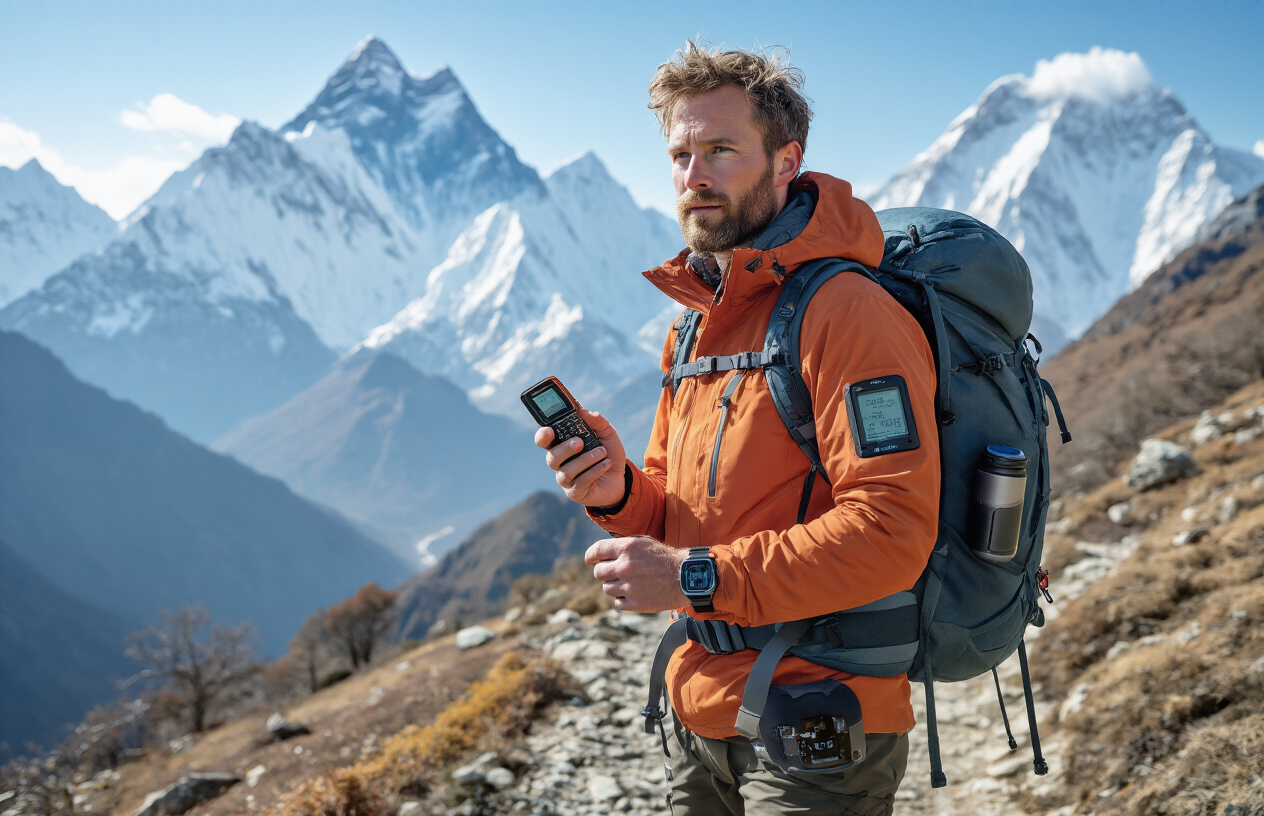
Satellite Communication Options in Remote Regions
Garmin inReach devices have become the gold standard for trekkers heading into Nepal's remote valleys. The latest models offer two-way messaging, weather updates, and SOS capabilities that work anywhere in the world. These compact units connect to the Iridium satellite network, ensuring communication even in the deepest gorges of the Khumbu or Annapurna regions.
Spot X devices provide another reliable option, featuring a full QWERTY keyboard for easier messaging. The 2025 models include enhanced battery life lasting up to 240 hours in tracking mode. Rental services in Kathmandu now offer these devices at competitive rates, making satellite communication accessible to budget-conscious trekkers.
For group expeditions, portable satellite WiFi hotspots like the Iridium GO! exec create internet bubbles in remote locations. These devices support multiple connections, allowing entire trekking groups to stay connected with families back home or coordinate with support teams.
GPS Tracking and Emergency Beacon Services
Modern GPS watches from Garmin, Suunto, and Coros now include detailed topographic maps of Nepal's major trekking routes. The Garmin Fenix 7X series preloads trails for Everest Base Camp, Annapurna Circuit, and Manaslu treks, complete with waypoints for tea houses and water sources.
Personal locator beacons (PLBs) have evolved beyond simple distress signals. The ACR ResQLink View displays GPS coordinates directly on the device, helping rescue teams pinpoint exact locations. These beacons work independently of subscription services, making them cost-effective for occasional trekkers.
Smartphone apps like Gaia GPS and AllTrails Pro now offer offline maps specifically designed for Nepal trekking. These apps sync with smartwatches, providing turn-by-turn navigation without draining phone batteries. Emergency sharing features automatically send location updates to designated contacts at preset intervals.
Mobile Network Coverage Expansion Updates
Nepal's major telecommunications providers have significantly expanded 4G coverage along popular trekking routes. Ncell and Nepal Telecom now provide reliable signals up to Everest Base Camp and throughout most of the Annapurna Circuit. New cell towers installed in 2024 have improved connectivity in previously dead zones around Gokyo Lakes and Thorong La Pass.
5G networks have launched in Kathmandu and Pokhara, offering lightning-fast internet speeds for final gear purchases and route planning. While 5G hasn't reached high-altitude areas yet, the improved infrastructure supports better 4G performance in mountain regions.
International roaming packages have become more affordable, with many providers offering specific Nepal trekking plans. These packages include generous data allowances and reduced rates for international calls, making it easier to stay connected without massive bills.
Digital Payment Systems in Mountain Villages
QR code payment systems have revolutionized transactions in Nepal's mountain communities. Most tea houses along the Everest Base Camp and Annapurna Circuit routes now accept payments through the eSewa and Khalti apps. Trekkers can load these digital wallets in Kathmandu and pay for meals, accommodation, and supplies without carrying large amounts of cash.
Mobile banking has expanded to surprising altitudes, with some tea houses in Namche Bazaar and Manang accepting bank transfers directly through smartphone apps. This development reduces the need to carry thousands of rupees in cash, improving both convenience and security.
International payment apps like Wise and Revolut work seamlessly at lower elevations, though cash remains king above 4,000 meters. Many trekkers now use a hybrid approach, carrying emergency cash while relying on digital payments whenever possible. Solar charging stations at major stops ensure devices stay powered for transactions.
Health and Medical Preparedness
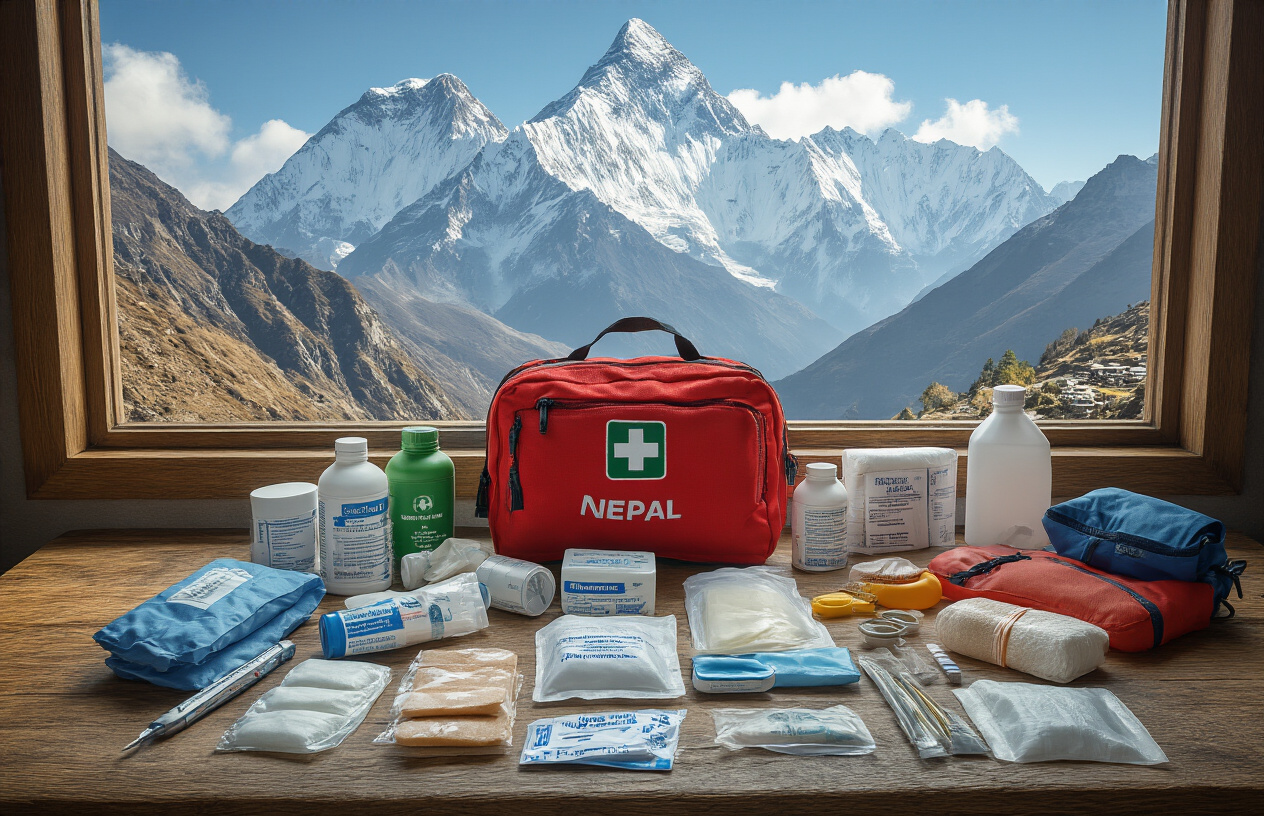
Altitude Sickness Prevention and New Treatment Options
The Himalayan altitude remains one of the biggest challenges for trekkers, but medical understanding has dramatically improved. Acetazolamide (Diamox) continues as the gold standard for prevention, but newer protocols recommend starting the medication 1-2 days before ascent rather than waiting until symptoms appear. The recommended dosage has also been refined - 125mg twice daily proves effective while minimizing side effects.
Dexamethasone has gained recognition as a powerful treatment option for severe altitude sickness, particularly high altitude cerebral edema (HACE). Many expedition medicine doctors now recommend carrying both medications, with dexamethasone reserved for emergencies when immediate descent isn't possible.
Portable pulse oximeters have become essential gear, allowing trekkers to monitor blood oxygen saturation levels. Readings below 85% at rest signal the need for immediate action. The "Lake Louise Score" system provides a standardized way to assess altitude sickness severity, helping trekkers make informed decisions about continuing their ascent.
New research emphasizes the importance of hydration markers - dark urine often indicates dehydration, which significantly increases altitude sickness risk. Pre-acclimatization techniques using altitude tents or hypoxic chambers are gaining popularity among serious mountaineers, though they remain expensive and aren't necessary for most recreational trekkers.
Updated Vaccination Requirements and Health Protocols
Nepal's vaccination requirements have evolved significantly following global health developments. Japanese encephalitis vaccination is now strongly recommended for trekkers visiting during the monsoon season (June-September) or spending extended time in rural areas below 2,000 meters. The newer Ixiaro vaccine provides better protection and fewer side effects compared to older options.
Hepatitis A and B vaccinations remain mandatory for most travelers, but combination vaccines now offer more convenient scheduling. Typhoid vaccination recommendations have shifted toward the injectable Vi-CPS vaccine, which provides longer protection than oral alternatives.
COVID-19 protocols continue changing, but most trekking agencies require proof of vaccination or recent negative tests. Travel insurance policies now specifically address pandemic-related cancellations, and many companies offer "COVID-19 coverage" as standard features.
Routine vaccines deserve attention too - measles outbreaks have occurred in several Asian countries, making MMR vaccination verification important. Diphtheria-tetanus-pertussis boosters should be current, especially given the dusty trail conditions that can lead to cuts and scrapes.
Water purification remains critical despite infrastructure improvements. Modern UV sterilization pens offer lightweight alternatives to traditional tablets, though boiling water remains the most reliable method at high altitudes where UV effectiveness decreases.
Medical Facility Improvements Along Major Routes
Medical infrastructure along Nepal's major trekking routes has improved substantially. The Everest Base Camp trail now features several well-equipped medical posts, including the Khunde Hospital renovation completed in 2024. This facility now houses an altitude chamber and can handle serious medical emergencies that previously required helicopter evacuation.
The Annapurna region has seen similar upgrades, with the Manang Health Post receiving new diagnostic equipment and expanded treatment capabilities. Satellite communication systems now connect remote medical facilities with Kathmandu hospitals, allowing for real-time consultation on complex cases.
Helicopter rescue operations have become more reliable and frequent. Weather delays still occur, but improved forecasting and multiple helicopter services reduce wait times. Rescue insurance costs have decreased while coverage has expanded - policies now typically include medical evacuation up to $100,000, compared to $50,000 just a few years ago.
Emergency oxygen supplies are now available at most teahouses above 4,000 meters, though quality and availability can vary. Many lodges have invested in basic medical training for staff, creating a network of first-aid capable individuals throughout the mountains.
Telemedicine consultations have revolutionized remote healthcare access. Trekkers can now video call with doctors in Kathmandu or even internationally, provided they have satellite internet access or reach areas with cell coverage. This development has proven particularly valuable for non-emergency medical questions and medication adjustments.
Sustainable Trekking Practices and Environmental Guidelines
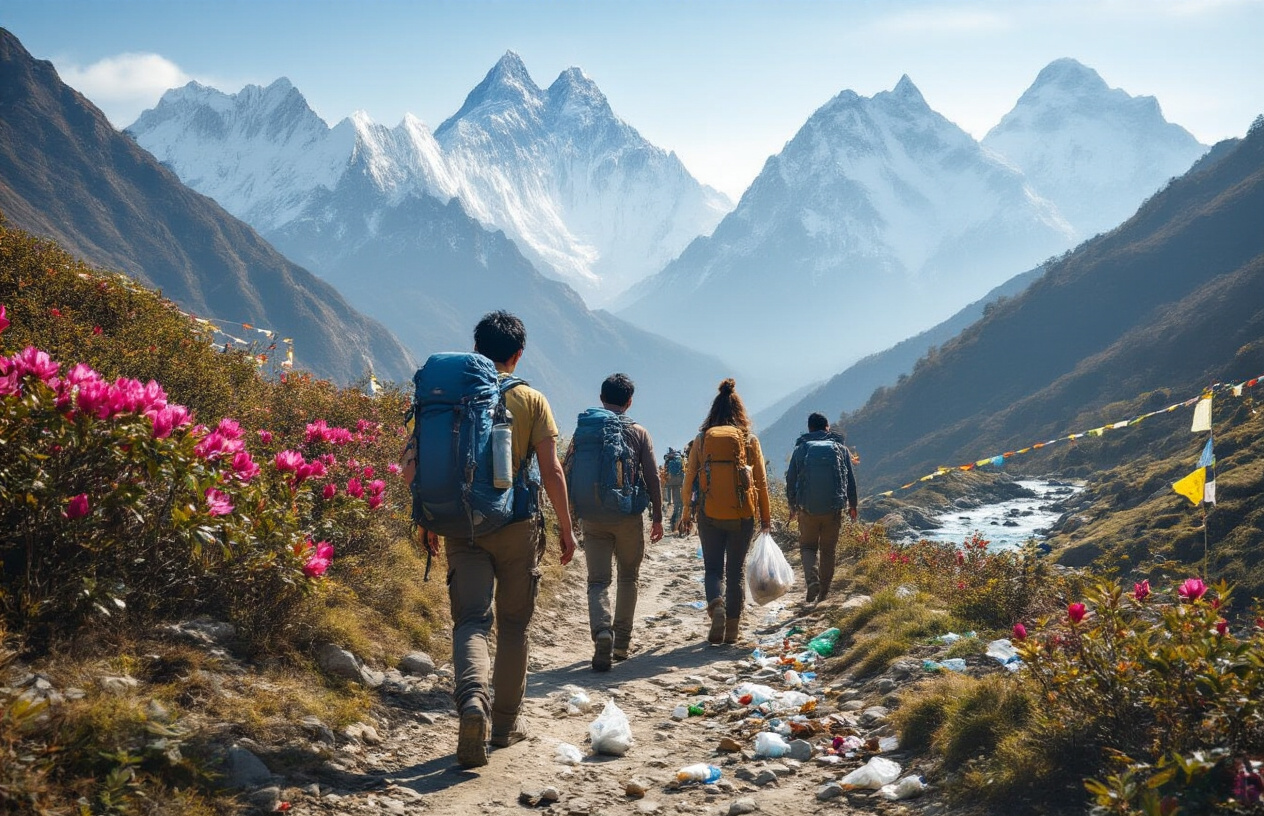
New Waste Management Initiatives
Nepal's government and environmental organizations have rolled out comprehensive waste management protocols for 2025 that every trekker needs to know about. The "Pack It In, Pack It Out Plus" initiative now requires trekkers to carry waste disposal tags that get checked at multiple points along popular routes like the Everest Base Camp and Annapurna Circuit.
Digital waste tracking systems have been installed at major checkpoints, where trekkers scan QR codes to log their waste disposal activities. Tea houses and lodges now provide standardized sorting bins for organic waste, recyclables, and non-biodegradable materials. The new system includes a deposit fee of $50 per trekker, refunded upon successful completion of waste management requirements.
Mountain communities have established waste collection hubs every 5-7 kilometers along major trails. These stations feature solar-powered compactors and basic recycling facilities. Local porters receive training and equipment to help maintain these stations while earning additional income through the waste management program.
Carbon Offset Programs for Trekkers
Mandatory carbon offset contributions became standard practice for all international trekkers entering Nepal in 2025. The Nepal Tourism Board partnered with verified carbon credit organizations to create the "Clean Peaks Initiative," calculating emissions based on international flights, domestic transportation, and estimated trekking activities.
Trekkers can now choose from three offset packages: Basic ($25-40), Standard ($50-75), or Premium ($100-150), depending on their travel distance and trek duration. These funds support reforestation projects in the Middle Hills, clean cooking stove distributions to mountain communities, and renewable energy installations at remote lodges.
The new online platform allows trekkers to track their offset contributions in real-time, showing exactly which projects benefit from their payments. Popular offset activities include planting native rhododendrons, supporting solar panel installations at monasteries, and funding biogas systems for local families.
Wildlife Conservation Updates and Regulations
Protected area regulations have become stricter in 2025, with enhanced monitoring systems and updated penalty structures. The Department of National Parks and Wildlife Conservation now requires wildlife encounter reporting through a mobile app, helping researchers track animal populations and behavior patterns.
New buffer zone restrictions limit group sizes to 12 people maximum in sensitive wildlife areas like Sagarmatha National Park and Annapurna Conservation Area. Noise pollution guidelines prohibit loud conversations, music, or equipment sounds within 500 meters of known wildlife habitats.
The revised regulations include specific guidelines for photographing wildlife, requiring trekkers to maintain minimum distances: 25 meters from large mammals like yaks and blue sheep, 10 meters from birds, and an absolute prohibition on feeding any wild animals. Drone usage faces complete restriction in all protected areas, with violations resulting in equipment confiscation and fines up to $500.
Local Community Support Requirements
The "Community First" trekking policy mandates that 60% of trekking expenditures must go directly to local businesses and services. This includes staying at locally-owned tea houses, hiring community-based guides and porters, and purchasing supplies from village shops rather than bringing everything from Kathmandu.
Fair wage standards now apply to all trekking staff, with minimum daily rates set at $25 for guides, $20 for assistant guides, and $18 for porters. These rates include meals, accommodation, insurance coverage, and proper gear provision. Trekking agencies must provide wage transparency documents to clients, showing exactly how much they reach local communities.
Cultural respect training has become mandatory for all trekkers, covering appropriate behavior around monasteries, interaction protocols with local families, and photography etiquette. Villages can now designate certain areas as photography-free zones, respecting privacy while still welcoming visitors. The new guidelines also require trekkers to learn basic Nepali greetings and cultural customs before starting their journey.
Community development fees range from $10-30 per person, depending on the region, for funding school improvements, healthcare facilities, and infrastructure maintenance in remote areas.
Conclusion
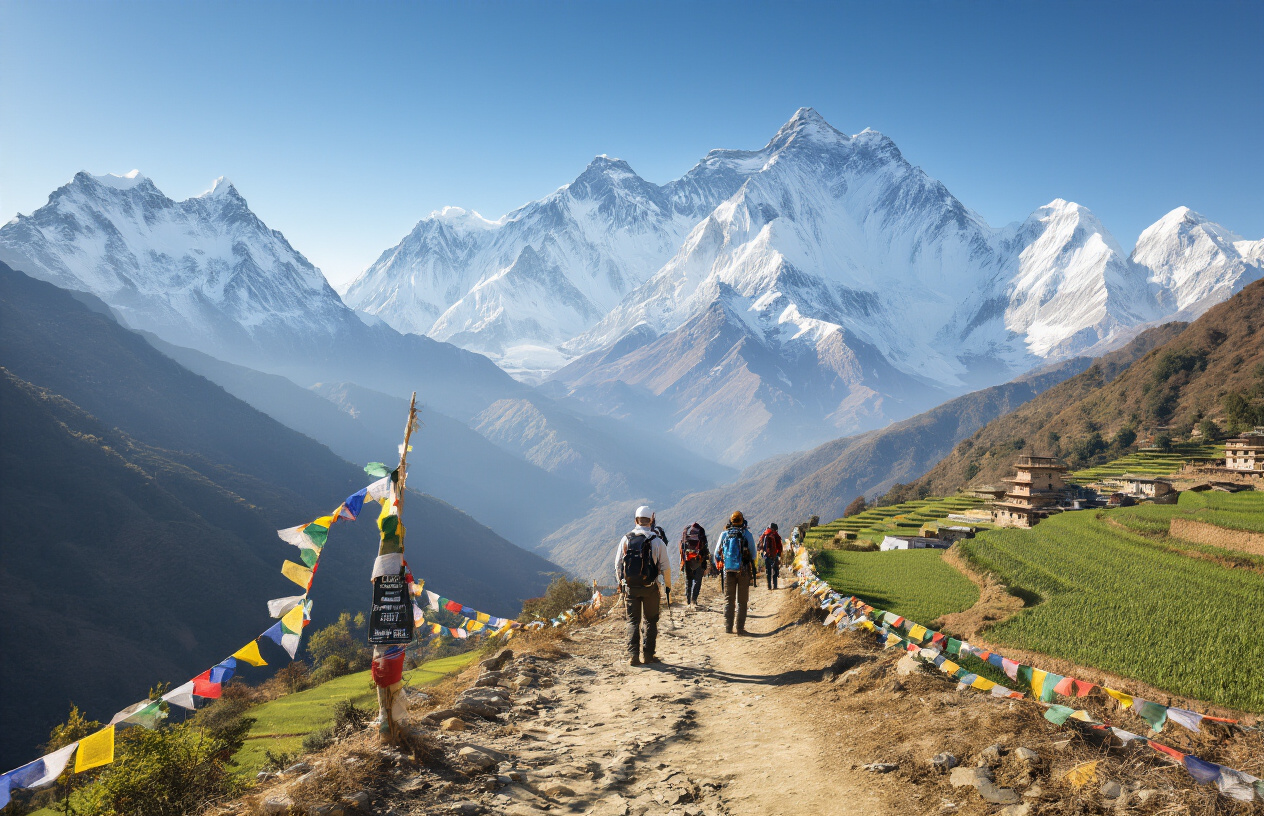
Create a realistic image of a triumphant Asian male trekker standing on a mountain summit in Nepal, wearing modern trekking gear and holding a GPS device, with the majestic snow-capped Himalayan peaks stretching endlessly in the background under a clear blue sky, prayer flags fluttering in the mountain breeze, showcasing well-maintained stone trail markers nearby, capturing the sense of achievement and adventure while emphasizing modern safety equipment and sustainable trekking practices, shot during golden hour lighting that creates a warm, inspiring atmosphere. Absolutely NO text should be in the scene.
Nepal's trekking landscape continues to evolve, bringing exciting opportunities alongside new responsibilities for adventurers. The safety improvements, infrastructure upgrades, and permit streamlining make 2025 an excellent year to explore the Himalayas. Technology now offers better navigation and emergency support, while enhanced medical preparedness ensures you're covered in remote areas.
The shift toward sustainable trekking practices isn't just about following guidelines—it's about preserving these incredible mountains for future generations. Start planning your Nepal adventure with these updates in mind, and remember that staying informed about current conditions and regulations will make your trek safer and more enjoyable. The mountains are calling, and they're more accessible than ever while remaining as awe-inspiring as always.
